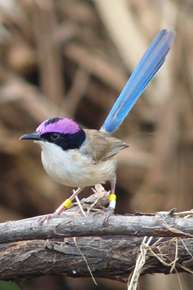Babysitting birds gain from growing pains

(�鶹��ԺOrg.com) -- The baffling question of why some animals help raise offspring which aren’t their own is closer to being answered, thanks to new research from The Australian National University.
Researchers have found that birds that help care for others’ nestlings gain both indirect and direct benefits and help more when the returns are greater.
Dr. Michelle Hall, a visiting fellow in the ANU Research School of Biology, was recently part of a long-term study on the cooperative breeding habits of purple-crowned fairy wrens. The study was led by Sjouke Kingma from the Max Planck Institute for Ornithology with Dr Anne Peters from Monash University as senior author.
Dr. Hall said that fairy-wrens are habitual cooperative breeders, with breeding pairs receiving help in the nest from non-breeding helpers. But in a first, the researchers found that helping in the nest boils down to both family and inheritance.
“Cooperative breeding has intrigued biologists for decades because individuals that help raise offspring that are not their own seem selfless,” she said. “It is an apparent contradiction to the predictions of natural selection.
“We spent many hours watching nests, monitoring who was feeding the nestlings, keeping tabs on changes in social groups, and recording when and where youngsters obtained breeding territories.
“By looking at the dynamics of these social groups we realised that when it comes to helping raise the young, it is a matter of relatedness. For example in purple-crowned fairy-wrens over 60 per cent of helpers live with both parents in the territory they hatched on and over 90 per cent live with at least one parent. So the young they help raise are usually siblings or half-siblings.
“We also found that in general helpers that are more closely related to the nestlings provide more help and their efforts thus see more of their shared genes entering the gene pool. In other words, helpers adjust their behaviour to maximise these indirect benefits by helping kin.”
While the findings present “an elegant theoretical solution” to the problem of unexpected animal altruism, Dr Hall said that they are by no means universally observed.
“In a twist, some helpers in purple-crowned fairy-wrens, and other cooperative breeders, also provide help for unrelated young in the nest. But it turns out these helpers are also playing a selfish game and maximising direct benefits by producing future helpers of their own.
“They help when their chances of inheriting the current breeding territory are greater, and thus are helping to raise their own future assistants.”
The study’s findings have been published in the latest edition of The American Naturalist.
Provided by Australian National University


















